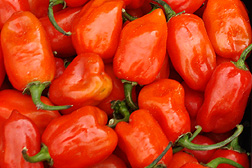This page has been archived and is being provided for reference purposes only. The page is no longer being updated, and therefore, links on the page may be invalid.
|
|
|
|
New Pest-Resistant Habanero Joins Peck of ARS-Created Peppers
By Stephanie YaoSeptember 22, 2009
A new red-fruited habanero is the latest pepper with resistance to root-knot nematodes to be released by Agricultural Research Service (ARS) scientists.
PA-559 is the first red-fruited habanero-type pepper released by ARS plant geneticist Richard Fery and plant pathologist Judy Thies-both with the agency's U.S. Vegetable Laboratory in Charleston, S.C.-that has resistance to the southern root-knot nematode. It is also resistant to the peanut root-knot nematode and the tropical root-knot nematode.
Root-knot nematodes are one of the three most economically damaging types of plant-parasitic nematodes on horticultural and field crops. They live in the soil in areas with hot climates and short winters, like those found in the southern United States. Damage from root-knot nematodes often results in poor plant growth, reductions in quality and yields, and reduced resistance to stresses such as drought and disease.
PA-559 is a relative of another root-knot-nematode-resistant cultivar, TigerPaw-NR, which was released by ARS in 2006. Both parental lines used to develop PA-559 are sister lines of TigerPaw-NR. PA-559 contains a dominant gene that gives the plant its pest-resistance trait. This makes the variety ideal for use as a parental line in breeding resistant cultivars because breeders can be sure the plant's offspring will contain resistance.
Field plantings conducted in Charleston over two years confirmed the pepper's pest resistance and showed that the fruit characteristics of PA-559 are comparable to those of currently available red-fruited habanero-type cultivars. The plant's fruit is extremely pungent, clocking in at 256,433 Scoville heat units. Habaneros typically score 100,000 or higher, whereas jalapeños range from 3,000 to 5,000 units.
Although recommended for use by breeders as a parental line, PA-559 can also be used in commercial production without further development.
Genetic material of this release is available for research purposes, including development and commercialization of new cultivars, from the National Plant Germplasm System.
ARS is the principal intramural scientific research agency of the U.S. Department of Agriculture.

